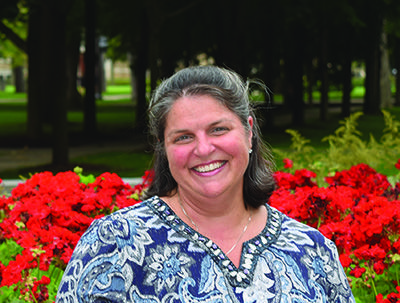 Christine Gebhardt
Christine Gebhardt
Green Dot, a national program that promotes bystander intervention in the fight against sexual assault and violence on campus, unites the array of other initiatives to address the problem in a way that builds a safe culture by enlisting everyone – staff, faculty and students – to do their part for the cause.
Increasing the display of the symbol – a custodian’s pin, a dining hall poster, a classroom mention or email signature line – fosters a sense of safety and support that attracts more participation in an upward spiral of community solidarity. Green Dot also uses red dots for choices that harm others by word or action and foster a culture of violence that Green Dot resists.
“Everybody has some part in it,” says Christine Caron Gebhardt, co-chair of the Committee on Sexual Assault Prevention (CSAP) and director of the Gender Relations Center. “Nobody has to do everything, but everybody has to do something. It helps people to realize that you have to send a cultural message as a campus that violence is not OK – that students, faculty and staff are supporting that.
“A custodian may not ever talk to a student about bystander intervention, but he or she can wear a green dot to help keep violence prevention visible to them. The message is that this is about all of us. The students begin to realize that there is a culture that is supporting them and encouraging them to look out for one another.”
The approach, created at the University of Kentucky in 2008, was launched at Notre Dame this fall, after CSAP decided it offered a needed common language and broad access.
Already, more than 40 people from a cross-section of the campus community, from ROTC, Student Activities, Campus Ministry and Residential Life to the Graduate School, Counseling Center and libraries as well as colleges and centers such as Mendoza and Kroc, are engaged in spreading the word.
Twenty-one people took 40 hours of training in May to become Green Dot facilitators. Thousands of students and hundreds of faculty and staff have heard overview speeches, which can be tailored from 20 to 90 minutes to fit a group’s needs.
Some committee members visit campus units to introduce the program while others give overview speeches to those who ask, and a six-hour bystander training is also available. A social media campaign supports the outreach to students.
The program provides an umbrella for organizations that support victims, provide resources or focus on prevention or intervention.
“All of those are important, but we have to have a common language, a common vision, a way in which we can unite as a community,” Gebhardt says. “This binds it all together. It gives it a vision that people can be invited to do, and they can engage at the level they’re comfortable with.
“It’s an amazing way in which different people across campus are coming together. It’s Notre Dame’s message and not one department’s message.”
For more information, visit the website.